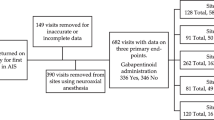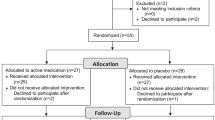Abstract
Purpose
Perioperative management after adolescent idiopathic scoliosis (AIS) surgery varies extensively between surgeons and institutions. We devised a questionnaire to assess surgeon baseline characteristics, practice settings, and pain regimens to assess what factors contribute to perioperative pain protocols.
Methods
A multiple-choice questionnaire including 130 independent variables regarding baseline characteristics, practice environments, and pain regimen protocols was distributed to elicit information among surgeons performing AIS fusion surgery. Pairwise bivariate analysis between practice location, length of practice, and practice environment vs. type of post-operative analgesia was completed using two-tailed Fisher's exact test.
Results
85 respondents participated, all identified as practicing orthopedic surgeons. The largest group of respondents reported 20–40% of their total practice was dedicated to AIS (36%). Respondents were predominantly hospital-employed academic physicians (67%). The most common pain medication administered preoperatively was gabapentin (54%). Postoperative regimens were highly varied. Discharge pain regimens most commonly included short-acting opiates (89%), acetaminophen (86%), antispasmodics (59%), and NSAIDs (51%). Bivariate analysis revealed that fentanyl PCA was significantly associated with practice location (p < 0.05). Utilization of NSAIDs was significantly associated with length in training, with older physicians utilizing anti-inflammatories more regularly than younger physicians (p < 0.05).
Conclusion
This study identifies common perioperative regimens utilized in AIS surgery. Of interest, younger surgeons are less likely to prescribe NSAIDs post-operatively than surgeons who have been in practice for longer periods of time, which may represent a bias against anti-inflammatory medications in younger surgeons.
Similar content being viewed by others
References
Bunnell WP (1988) The natural history of idiopathic scoliosis. Clin Orthop Relat Res. https://doi.org/10.1097/00003086-198804000-00003
Ascani E, Bartolozzi P, Logroscino CA et al (1986) Natural history of untreated idiopathic scoliosis after skeletal maturity. Spine. https://doi.org/10.1097/00007632-198610000-00007
Shah SA, Guidry R, Kumar A et al (2020) Current trends in pediatric spine deformity surgery: multimodal pain management and rapid recovery. Glob Spine J. https://doi.org/10.1177/2192568219858308
Fletcher ND, Andras LM, Lazarus DE et al (2017) Use of a novel pathway for early discharge was associated with a 48% shorter length of stay after posterior spinal fusion for adolescent idiopathic scoliosis. J Pediatr Orthop. https://doi.org/10.1097/BPO.0000000000000601
Rusy LM, Hainsworth KR, Nelson TJ et al (2010) Gabapentin use in pediatric spinal fusion patients: a randomized, double-blind, controlled trial. Anesth Analg. https://doi.org/10.1213/ANE.0b013e3181d41dc2
Mayell A, Srinivasan I, Campbell F et al (2014) Analgesic effects of gabapentin after scoliosis surgery in children: a randomized controlled trial. Paediatr Anaesth. https://doi.org/10.1111/pan.12524
Hayes J, Pehora C, Bissonnette B (2009) The use of NSAIDs in pediatric scoliosis surgery—a survey of physicians’ prescribing practice. Paediatr Anaesth. https://doi.org/10.1111/j.1460-9592.2009.03060.x
Munro HM, Walton SR, Malviya S et al (2002) Low-dose ketorolac improves analgesia and reduces morphine requirements following posterior spinal fusion in adolescents. Can J Anesth. https://doi.org/10.1007/bf03017921
Van Boerum DH, Smith JT, Curtin MJ (2000) A comparison of the effects of patient-controlled analgesia with intravenous opioids versus epidural analgesia on recovery after surgery for idiopathic scoliosis. Spine. https://doi.org/10.1097/00007632-200009150-00014
Sivaganesan A, Chotai S, White-Dzuro G et al (2017) The effect of NSAIDs on spinal fusion: a cross-disciplinary review of biochemical, animal, and human studies. Eur Spine J. https://doi.org/10.1007/s00586-017-5021-y
Scheer J, Sethi R, Hey L, LaGrone M, Keefe M, Aryan H, Errico T, Deviren V, Hart R, Lafage V, Schwab F, Daubs M, Ames C (2017) Results of the 2015 scoliosis research society survey on single versus dual attending surgeon approach for adult spinal deformity surgery. Spine 42(12):932–942. https://doi.org/10.1097/BRS.0000000000002070
Lee CS, Merchant S, Chidambaran V (2020) Postoperative pain management in pediatric spinal fusion surgery for idiopathic scoliosis. Pediatr Drugs. https://doi.org/10.1007/s40272-020-00423-1
Funding
No funding was received for conducting this study.
Author information
Authors and Affiliations
Contributions
SJG, ALM, BC, SKC, AKA, and SCR made substantial contributions to the conception or design of the work; or the acquisition, analysis, or interpretation of data; or the creation of new software used in the work; SJG, ALM, BC, SKC, AKA, and SCR drafted the work or revised it critically for important intellectual content; SJG, ALM, BC, SKC, AKA, and SCR approved the version to be published; SJG, ALM, BC, SKC, AKA, and SCR agreed to be accountable for all aspects of the work in ensuring that questions related to the accuracy or integrity of any part of the work are appropriately investigated and resolved.
Corresponding author
Ethics declarations
Conflict of interest
The authors have no relevant financial or non-financial interests to disclose.
Ethics approval
As this study involved no patient data or human or animal subjects and was an analysis of institutional pain protocols, no institutional review board approval was required. As this study involved no patient data or human or animal subjects and was an analysis of institutional pain protocols, informed consent does not apply for this study.
Additional information
Publisher's Note
Springer Nature remains neutral with regard to jurisdictional claims in published maps and institutional affiliations.
Rights and permissions
Springer Nature or its licensor (e.g. a society or other partner) holds exclusive rights to this article under a publishing agreement with the author(s) or other rightsholder(s); author self-archiving of the accepted manuscript version of this article is solely governed by the terms of such publishing agreement and applicable law.
About this article
Cite this article
Girdler, S.J., Lieber, A.M., Cho, B. et al. Perioperative pain protocols following surgery for adolescent idiopathic scoliosis: a snapshot of current treatments utilized by attending orthopedic surgeons. Spine Deform 12, 57–65 (2024). https://doi.org/10.1007/s43390-023-00741-7
Received:
Accepted:
Published:
Issue Date:
DOI: https://doi.org/10.1007/s43390-023-00741-7




